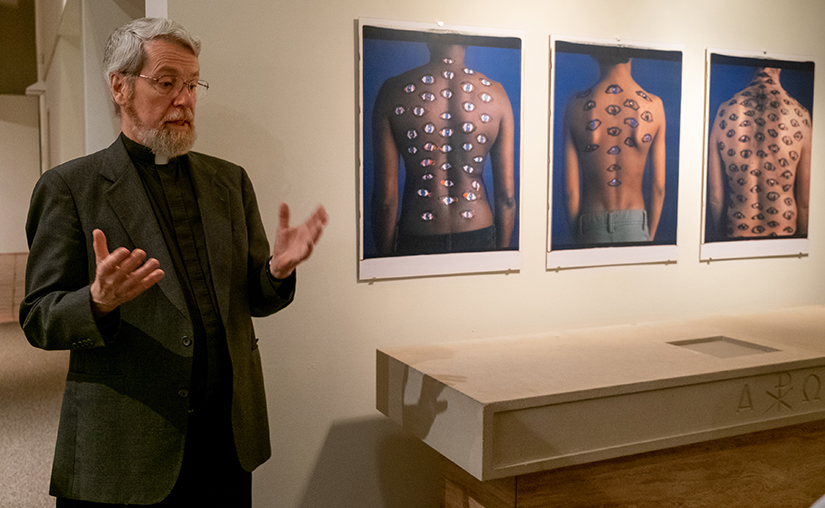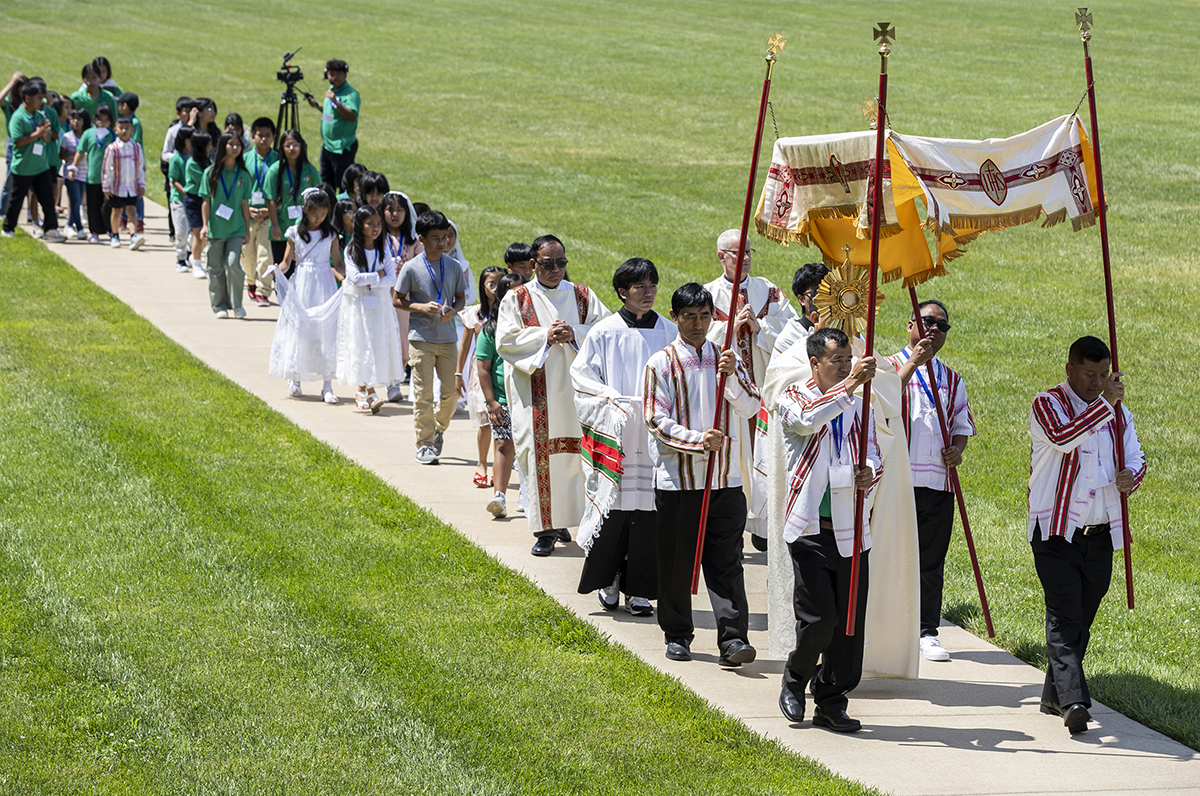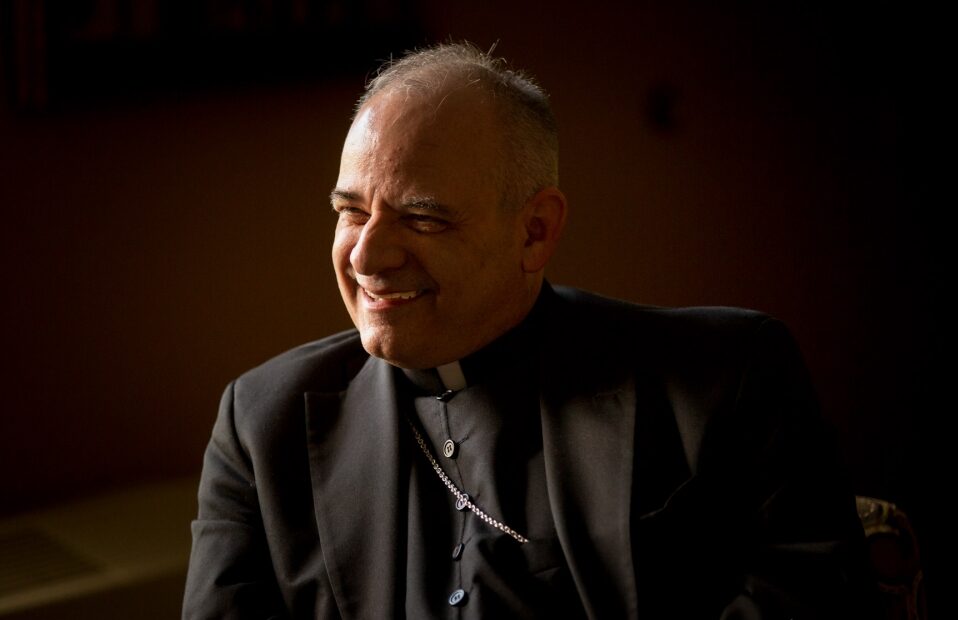Art museum’s contemporary, interreligious aspect sets it apart

Museum at SLU honors 25 years of displaying contemporary religious art

There’s a reason there are chairs placed in front of James Rosen’s “Homage to the Pietà d’Avignon” (1989-91) at the Museum of Contemporary Religious Art at Saint Louis University.
That’s because the artwork is so peaceful and mysterious, it’s well worth a long reflection. People who stop to observe it generally lower their voices to a whisper as they approach it. Painted with layers of oil and wax, the colors gradually reveal themselves.
Studying the image of the body of Jesus in the arms of His mother taken down from the cross, Saint Louis University freshman Ben Kelly of Annunciation Parish in Webster Groves lowered his voice and explained his interest in it. Kelly, viewing the art with classmates from his theology class, added that the image motivated him to read the accompanying placard about the artist and what inspired him.
Jesuit Father Terrence Dempsey, the museum’s founding director, earlier explained the interfaith dimension of the artwork by Rosen honoring a renowned 15th-century painting. “I once asked him, ‘Jim, you are a devout Jew. Why do you paint Madonnas, crucifixions and saints associated with the Catholic tradition?’ He responded, ‘Some images are so powerful that they transcend particular traditions and speak to the heart of all humanity.’”
The current exhibition of 25 artists honors the 25th anniversary of MOCRA, which opened in a renovated seminary chapel on the campus of Saint Louis University in 1993. Since then, through the course of more than 60 exhibitions, accompanied by wide-ranging programs (including a podcast), MOCRA has continued to promote dialogue between artists and religion and spirituality and between viewers and artworks.
Curated by Father Dempsey, “MOCRA: 25” includes works from the MOCRA collection and a few works on loan, just a sample of the 25 years of exhibits. Only two of the artists have not exhibited there previously.

The Museum of Contemporary Religious Art began with the idea that many of today’s visual artists engage with the religious and spiritual dimensions in their work — even if they sometimes go about it in ways quite different from prior generations. “I love the art of tradition,” Father Dempsey said. “But most of that was commissioned. And it was a very different type of artistic enterprise.”
There’s no one style that best reflects the religious dimension of MOCRA’s art, he said. Pointing to five of the artworks in the front of the display, Father Dempsey said, “There’s a Jewish artist, next to a Greek Orthodox artist, next to a Roman Catholic artist, next to a Muslim artist, next to a Native American artist. … (In) a time when religious differences have resulted in some horrible things happening, this idea of having the works by artists addressing the spiritual and religious dimensions in dialogue with one other is more timely than ever before.”

MOCRA opened as the first museum of its kind, and it still may be the only contemporary religious art museum. Father Dempsey credits his mentor, the late Jesuit Father Maurice McNamee, professor of art history and director of Cupples House at SLU, with the idea of using the then-empty chapel as the space for MOCRA. Volunteer architects Paul Marti, Dan Esarey and others advised him in the effort. Some of the side chapels used as exhibit space include the altars that were there previously.
Javier Orozco, executive director of human dignity and intercultural affairs for the Archdiocese of St. Louis, said the museum, in the context of interreligious activity, “invites us to bring forth the best of the human spirit … and be mindful of that deeper sense of human dignity, mystery and beauty.”
Mary Dunn, who teaches Kelly’s course on the basics of theology, said the religious elements of the art are worth exploring. Referencing Michael Tracy’s “11th, 12th and 13th Stations of the Cross for Latin America — La Pasion,” which is included in the exhibit, Dunn said “it challenges people to think about their habituated, familiar faith in a different way. A lot of the art gathered here brings those more contemporary Catholic social teaching concerns together with Scripture and Tradition.”
>> MOCRA
Saint Louis University’s Museum of Contemporary Religious Art (MOCRA) is the world’s first interreligious museum of contemporary art that engages religious and spiritual themes. MOCRA is dedicated to the ongoing dialogue between contemporary artists and the world’s religious traditions and to serving as a forum for interreligious understanding. MOCRA intends to be inclusive and embracing, a center for healing and reconciliation.
The museum’s founder, Jesuit Father Terry Dempsey, describes religious art as “a variety for media that expresses a genuine engagement with the religious dimension, and in that religious dimension, one moves beyond surface, material, mundane existence to an exploration of the human concerns of suffering, love, mortality, immortality and a connectedness to something greater than ourselves. It can be an expression of faith or it can be a genuine inquiry and exploration of the religious dimension — a search for mystery, and perhaps for answers.”
The Society of Jesus (the Jesuits) has a long association with various artistic disciplines, including music, dance and visual art. This engagement is rooted in Ignatian spirituality, a way of living out one’s faith in the world, grounded in the insights of the founder of the Jesuits, St. Ignatius of Loyola. Central to Ignatian spirituality is the belief that God may be found in all things — an assertion that we can encounter the divine in all aspects of our lives and in all of our circumstances.
On exhibit
WHAT: MOCRA 25, marking a quarter century of exhibitions and programming
WHO: 25 artists
WHERE: Museum of Contemporary Religious Art (MOCRA) at Saint Louis University, 3700 West Pine Blvd. (a pedestrian mall) on SLU’s campus
WHEN: Tuesday-Sunday, 11 a.m. to 4 p.m. through Feb. 17 (closed Dec. 22 through Jan. 7); Admission is free, though there is a suggested donation of $5, or $1 for students and children.
FOR INFORMATION: Visit www.mocra.slu.edu or call (314) 977-7170
Saint Louis University students Morgan Pessina, left, and Cat Carlin viewed the exhibition MOCRA: 25 on Nov. 27Photo Credit: Sid Hastings There’s a reason there are chairs placed in front … Art museum’s contemporary, interreligious aspect sets it apart
Subscribe to Read All St. Louis Review Stories
All readers receive 5 stories to read free per month. After that, readers will need to be logged in.
If you are currently receive the St. Louis Review at your home or office, please send your name and address (and subscriber id if you know it) to subscriptions@stlouisreview.com to get your login information.
If you are not currently a subscriber to the St. Louis Review, please contact subscriptions@stlouisreview.com for information on how to subscribe.






